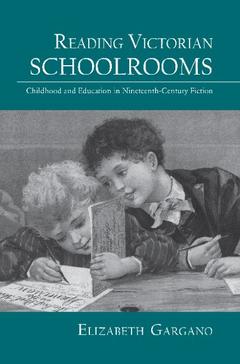Reading Victorian Schoolrooms Childhood and Education in Nineteenth-Century Fiction Children's Literature and Culture Series

Reading Victorian Schoolrooms examines the numerous schoolroom scenes in nineteenth-century novels during the fraught era of the Victorian education debates. As Gargano argues, the fiction of mainstream and children?s writers such as Dickens, Brontë, and Carroll reflected widespread Victorian anxieties about the rapid institutionalization of education and the shrinking realm of domestic instruction.
As schools increasingly mapped out a schema of time schedules, standardized grades or forms, separate disciplines, and hierarchical architectural spaces, childhood development also came to be seen as regularized and standardized according to clear developmental categories. Yet, Dickens, Brontë, and others did not simply critique or satirize the standardization of school experience. Instead, most portrayed the schoolroom as an unstable site, incorporating both institutional and domestic space.
Drawing on the bildungsroman?s traditional celebration of an individualized, experiential education, numerous novels of school life strove to present the novel itself as a form of domestic education, in contrast to the rigors of institutional instruction. By positioning the novel as a form of domestic education currently under attack, these novelists sought to affirm its value as a form of protest within an increasingly institutionalized society. The figure of the child as an emblem of beleaguered innocence thus became central to the Victorian fictive project.
Introduction 1. 'The Idea of a Wall': Toward a New Architecture of School and Mind 2. From Felix’s Cottage to Miss Temple’s Parlor: Domestic Instruction and the Paradox of the Teacher’s Room 3. Level Playing Fields and Locked Gardens: Nature at School 4. The View from the Sickroom Window: Zymosis, Brain Fever, and the Dangers of Institutional Education. Conclusion
Elizabeth Gargano is Assistant Professor of English at the University of North Carolina at Charlotte.
Date de parution : 04-2012
15.2x22.9 cm
Date de parution : 11-2007
15.2x22.9 cm
Mots-clés :
tom; browns; schooldays; david; copperfield; garden; brown; nicholas; nickleby; crofton; Tom Brown’s Schooldays; Healthful Activity; Vice Versa; Crofton Boys; Tom Brown; School Narratives; Domestic Education; School Garden Movement; School Garden; Paul Dombey; Dotheboys Hall; Mandatory Primary Education; Foreign School Society; Raw Human Nature; Nicholas Nickleby; Teacher’s Room; School Novels; Young Men; Circuitous; Miss Temple; Unhealthy House; School Illnesses; Overburdened; Shelley’s Monster; Familial Inclusion



